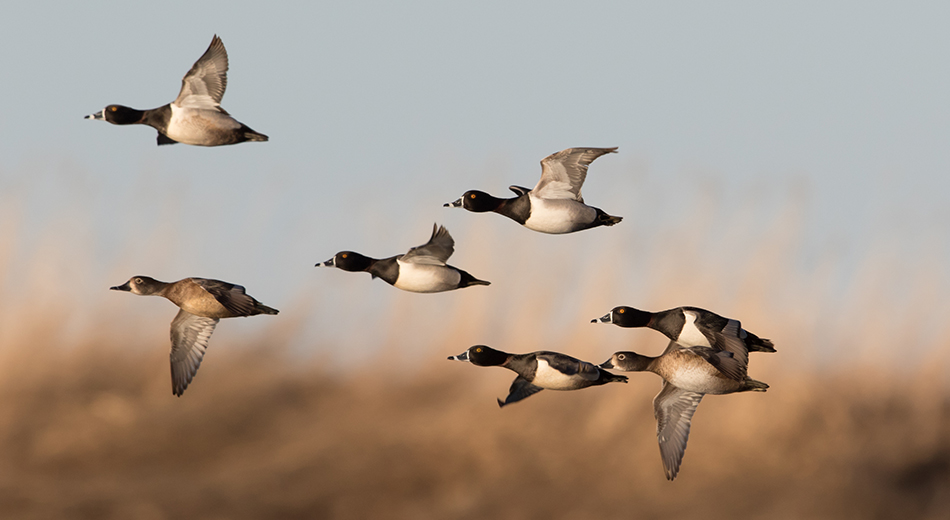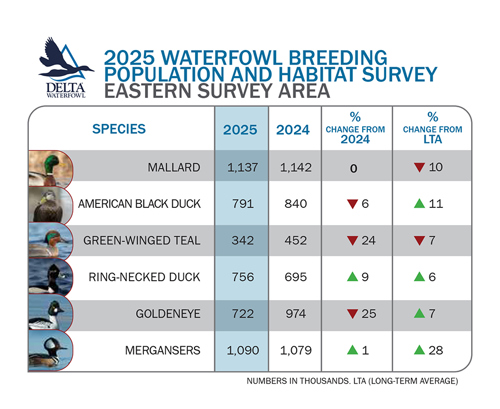
Eastern Survey Area Duck Populations Remain Strong
Results from the Eastern Survey Area are typically an underreported aspect of the Breeding Waterfowl Population and Habitat Survey conducted each spring by the U.S. Fish and Wildlife Service, Canadian Wildlife Service, and Flyway Council partners. However, the ESA data is extremely important for Atlantic Flyway waterfowl hunters.
Season frameworks and bag limits for the Atlantic Flyway states are set using a multi-stock model of population for green-winged teal, ring-necked ducks, goldeneyes, and wood ducks from the ESA and the Atlantic Flyway Breeding Bird Survey. These estimates produced a recommendation for a liberal regulations package, which means a 60-day duck season with a six-duck daily bag limit again for 2026-2027.

Mallards in the ESA declined ever so slightly to 1.137 million, less than a 0.5% drop from 2024. The mallard breeding population is 10% below the long-term average. However, the estimate is high enough that hunters should again enjoy a four-mallard daily limit to include two hens in 2026-2027, the same as this upcoming duck season.
Black ducks declined 6% from 2024 to an estimate of 791,000, however they remain a healthy 11% above the long-term average. For U.S. hunters, a moderate harvest package of two black ducks daily is prescribed. Canadian hunters in the Atlantic Flyway will enjoy liberal harvest regulations for black ducks, which vary by province.
Ring-necked ducks, an important species for many hunters — especially in the southern reaches of the Atlantic Flyway — increased 9% to 756,000 in the ESA. Delta Waterfowl research shows that many of the ringnecks that winter in the southeast arrive from western breeding areas such as Minnesota, Saskatchewan, Manitoba, and Western Ontario. While the ringneck breeding population for the Traditional Survey Area wasn’t specified in the 2025 Waterfowl Population Status Report, they have numbered more than 2 million in recent years. If you rely on ring-necked ducks, you should have a good season.
Wood duck populations are stable in northeast states of the Atlantic Flyway, with a reported estimate of 900,000, which is similar to the long-term average.
Other ESA results show green-winged teal declined 24%, while goldeneyes dropped 25%. Mergansers, which include common, red-breasted, and hooded, remain abundant, increasing 1% to 1.09 million.
Habitat conditions in the ESA were deemed good to excellent across most of the region, so good duck production should result.
Importantly, several prairie and western nesting species that migrate to the Atlantic Flyway increased. Redheads were up 17% and canvasbacks rose 22%, while gadwalls, wigeon, and pintails also posted solid gains over their 2024 population estimates. However, the prairies were dry, so duck production might be suppressed for many of these species. Scaup were down 10%, and blue-winged teal declined by 4% in the spring survey.
The Waterfowl Population Status Report also details goose populations, which reveal that Atlantic Population Canada Geese increased to 150,000, a 68% increase from 2024. Although the season frameworks for geese are not set yet for 2026-2027, hunters of AP geese might be afforded more opportunity than this season’s 30-day, one-goose daily limit. — Paul Wait
